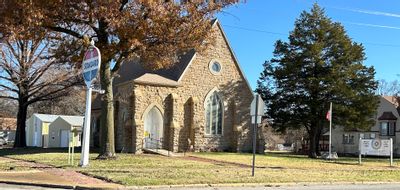
Girard History Museum
St John’s Episcopal Church
National Register of Historic Places
Circa 1886 – 1888
The official organization of St John’s Protestant Episcopal Church took place in May 1871. Dr. William H. Warner and Mark Elliot were wardens, and the vestrymen were C. Dana Sayrs, Thomas C. Patterson, C. G. Hawley, Percy Daniels, and M. M. Flint. The incorporation papers were signed by Franklin Playter. In July 1873 two lots at the southeast corner of Summit and Buffalo were purchased, and a house on this location was used as a temporary chapel for several years. Henry Albert Schmidt was the Architect who drew up the plans and in 1886 the construction of a new stone church was begun. The stone was purchased at 75 cents per perch of 2100 pounds from George Priestly’s stone quarry, near the cemetery southwest of town. The church completed in 1888, was 30 X 60 feet, and 40 feet high at the peak of the steep roof. Inside it is filled with oak and has oak floors. The stained-glass windows were shipped from St Louis and are quite valuable today, giving the building much character. In 1917 a pipe organ was installed as a gift from Harriet Nye Towne of Marietta, Ohio, in memory of Capt. John Dana Barker and his wife were from Marietta too. The organ was built by the Vogel-Barker-Cisler Company of Marietta.
Col. Quentin Pease, originally from Pittsburg, who was married to Sallie Flint, whose family had been connected with the church since its beginning, retired in Girard and headed a movement to acquire the beautiful little church as a museum for Girard and the surrounding area.
The Museum of Crawford County’s deed was transferred to the Friends of Historic Girard in 2015 and the name was changed to the Girard History Museum.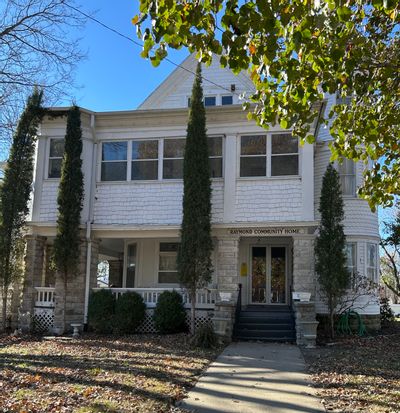
National Register of Historic Places 2007
Raymond Community Home
Given to the city by Mrs. J. E. (Mary) Raymond
CIRCA 1893
The Raymond Community Home is a large and beautiful Victorian home built by J. A. Raymond in 1893. By terms of his will, his widow was given life estate, and then at her death, it was to become the property of the City of Girard for a community center, administered by a committee from the ladies’ clubs. Ellen Kirkpatrick, nee Cloyd, Mrs. Raymond’s niece, for who they had built a home on the back part of the lot, was given the privilege of buying their large home, but she declined.
In May 1931, Mary Raymond offered the downstairs of her home to the Chamber of Commerce, which was accepted unanimously. Late in the year she gave up her life interest in the property and deeded it to the City of Girard. The house lost some of its original features when the upstairs screened-in porch was added.

Located on the SE corner of the square. Was dedicated March 3, 1995, Army 64-13623 and was retired from service by the Department of the Army and assigned to the Stephen H. Bennefeld V. F. W Post 7479, Girard KS with a total of 5,524.7 aircraft hours. Kansas Vietnam Veterans Memorial.
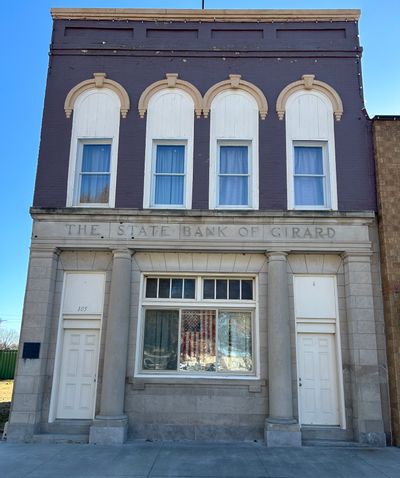
First State Bank
Placed On the National Register of Historic Places in 2009
It was the First Brick Building in Girard, built by attorney Franklin Playter, in 1873. In 1874 Franklin Player financed the construction of an RR from Girard to Joplin. For some time there was only one small engine.
The road was taken over by the Fort Scott and Gulf, later the Frisco. His plans to locate a station about midway from Girard to Joplin led to his selection of Fourth and Broadway where he built the first business at the southwest corner of that intersection, and the town was called Pittsburg.
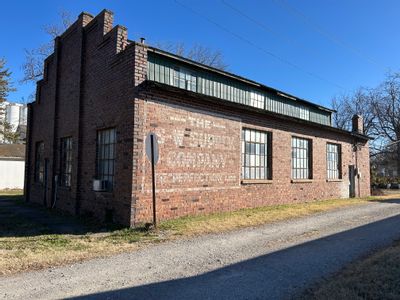
National Register of Historic Places 2009 Grave markers, plant and nursery stakes, chicken feeders, and more were made by Marion Slawson of the S-W Supply Company, shipping to every state and foreign country. The plant was in operation with all of the original equipment until 200?
Grocery of R. T. Grant 1904
Father of Jane Grant
Co-Founder of the New Yorker Magazine
Circa 1874
Jane Grant was born in Girard in 1892, the younger daughter of R. T. and Sophronia (Cole) Grant. Grant and his wife’s parents, Gideon P. Cole and Elizabeth Brown, came from Canada. Gideon P. Cole at the age of sixteen went to sea with his older brother, a sea captain, for five years. Later he farmed in Illinois and was again employed as a sailor before coming to a farm southeast of Cato in 1868, where he had 530 acres of land. In 1883 he moved to Farlington, and a few years later to a farm at the edge of Girard. He was a road supervisor, justice of the peace, school board member, and a devout Baptist. His first wife Elizabeth Brown, by whom he had nine children, was said to have been a relative of John Brown and Roger Williams, who was driven from the Massachusetts Bay Colony and founded Providence in 1636. By his second wife, Gideon Cole had seven more children. Both wives were redheads. George E. Cole, county clerk several times and Kansas state auditor was a child of the first wife, as was Sophronia, who became the mother of Jane Grant.
Sophronia Cole was a teacher, and according to her daughter’s recollection, she was the first female in Kansas to hold a first-grade teaching certificate. At her death, she left two daughters, Edith, 14, and Jane, 6. Jane excelled at music and gained a reputation for singing and performing as a small child. Her teacher, Mrs. Volney Boaz, planned to retire from teaching, so it was suggested that Jane might go East to study for a year, return to Girard, and take over as music teacher. However, Jane had other ideas, knowing that if she went “East” she wanted to stay and become a singer or actress. At the age of 16, after graduating from the three-year course at Girard High School, Jane was on her way to New York to study music. That spring, Miss Willie Warner, who had married and lived at Roselle Park, a short distance from New York City, finally returned to visit Girard after many years’ absences. When she heard Jane sing, invited her to come live with her and her husband and study music.
After the death of Miss Willie, two of her friends helped Jane with her musical education. Financially it was hard going, so Jane wrote to her father for financial help, but he didn’t wish to help. She then wrote and asked him to sell her mother’s piano and send her the money. A much-needed check arrived, but later when she visited her father, she found her piano still there. Finally, she got a job at the New York Times taking down society items, and from that beginning, she became a journalist and reporter. During World War I she served nearly a year in France with the motion picture bureau of Y.M.C.A., and also entertained troops. There she met Harold Ross, a native of Aspen, Colorado, who had become the editor of the Stars and Stripes. When the war was over she received a promotion from the New York Times and Married Ross. Ross and she then founded the New Yorker magazine. Jane, who retained her maiden name of Grant, became a noted reporter, wrote for the Saturday Evening Post, and interviewed many famous people, including wives of presidents. She also covered the flight of Charles Lindbergh in 1927. When Jane’s relatives and members of the Chamber Commerce of Girard heard that she was acquainted with Lindbergh and that he was planning to fly over several towns and drop greeting scrolls, they bombarded her with telegrams to ask “Lindy” to fly over Girard. She told Lindbergh as a child she had witnessed the unsuccessful flight of the first airship manufactured west of the Mississippi River. He readily granted her request.
Harold Ross and Jane Grant, (as founding president of the Lucy Stoner League, she retained her maiden name), once visited Girard, where Jane introduced her husband to her old and dear friend Marcett Haldeman-Julius, and Emanuel, the noted publisher. One might have expected the two men to have had much in common; yet when Ross found out Emanuel was no longer a Socialist, having made so much money selling Little Blue Books, he rejected any possible friendship.
Jane’s marriage to Harold Ross ended in divorce after nine years, but even after that she had a great influence on the New Yorker magazine and was one of the noted writers of her day.
She later married William B. Harris, editor of Fortune magazine. Upon their retirement, they founded White Flower Farm, a prestigious seed company in Connecticut. She died on March 126, 1972.
A large brick building on this site was used by the Appeal to Reason Newspaper in 1896. Its Publisher, J. A. Wayland, was a Socialist. About 750,000 copies were mailed out weekly in 1913 all across the world and was the largest circulated newspaper at that time. It was later home of the Little Blue Books with the first printing in January 1919 published by Emanuel Haldeman-Julius. It had the largest printing presses west of the Mississippi. The plant burnt on July 4, 1978. 100 million copies of the Little Blue Books were sold in 1926.
The Presbyterian Church was to be built of brick for a cost of $8,000 in 1887. The cathedral art glass windows were added in 1914, the two large windows on the north and south being donated by Mrs. Mary E. Raymond and Mrs. S. Alice Haldeman. Rev. Preston McKinney was a minister in 1883 when he brought the first typewriter to Girard. He was killed in the 1906 San Francisco earthquake.
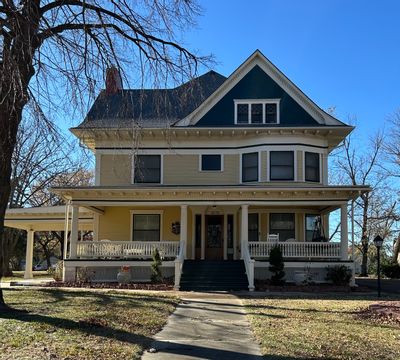
National Register of Historic Places 2017 Built by J.T. and Anna Leonard
One of Girard’s leading Families
It is significant for its architecture Circa 1907-08
The house was designed in a late version of free classic Queen Anne style, a building type not widely used in Girard. It was the largest house built in Girard at the time. It was said that a ton and a half of nails were used to build the house, and the wall studs were double two by sixes.
Home of Socialist lawyer, author, and lecturer who arrived in Girard from New York in February 1908 with blueprints for a flying machine. The first plane west of the Mississippi was built on July 9, 1908, and was christened the “Great Dream”.
It was dubbed the ”Mayfly, because, after all, as they said it may fly! But it didn’t. Call built 14 planes in all and many engines. Because of his efforts, Charles Lindbergh flew over Girard I 1927 dropping a greetings scroll of congratulations on the south side of the square.
A founding family with 10 children (5 of which settled in Girard). Captain John and three sons were shipcaptains in the Great Lakes. In 1883 they purchased 80 acres in Northwest Girard and named it “Higgie Addition”. All of the family built large homes on the west side of Summit. Son John M’s home was the Northernmost Victorian home in 1887.
The next home was built by J. F. Moore in 1887. The next two homes are gone and the fifth was built in 1886 and was for Capt. William Higgie and wife. The family-owned a 15-acre lake and grounds surrounding N. Leonard Street.

In 1888 the John F. Moore family (J. A. Wayland) home was the 2nd one built just south of John M. Higgie’s home. The style of the building was Victorian. It was larger than John Higgie’s and had a basement 7 feet in the clear, under to the whole structure, which is 37 x 50 feet.
This was a two-story structure; the first floor was 11 feet, second 10 feet. As you enter from the front porch a wide hall, 7 ½ x 17 presents itself; then a parlor 14 x 17; sitting room, 15 x 16; library 14 x 15; dining room 12 x 15; kitchen 10 x 15. The second floor is reached on what are called platform stairs. First bedroom, 12 x 17; 2nd, 8 x 9; 3rd, 15 x 15; 4th, 13 ½ x 15; 5th, 11 x 13 ½; 6th, 10 x 12, all finished in cypress, and having good closets. Below, the hall, parlor, and sitting room have a rich colored redwood finish, trimmed with gum; the library in cypress and redwood; the kitchen and dining room in oak and gum, with walnut trimmings.
All the work is first class and the house is built for the comfort of its occupants. Three mantles, one each in the parlor, library, and dining room, will warm the apartments. The total cost of the building is $5,000. “The Allen Brothers are the contractors for said buildings and John R. Garrison has charge of the entire inside work, and J. W. Ballard of the outside carpenter work.” A local newspaper stated that Mr. Moore of Chicago was finishing a $6,000 mansion in Higgie‘s Addition.
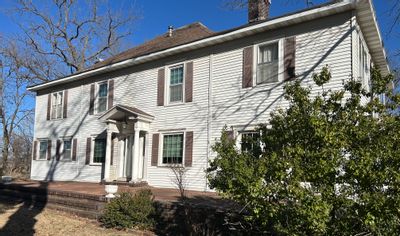
Kansas State Register of Historic Places 1988
Home of Emanuel & Marcett Haldeman-Julius
1918-1951
Publisher of the Little Blue books
Circa 1893
Emanuel Julius was born in a Philadelphia ghetto, a child of Russian immigrants who had changed their name from Zolajefsky to Julius. His father was a bookbinder of fine books, which Emanuel learned to appreciate. At seventeen he struck out for New York and had no contact with his family for 10 years. In 1915 he arrived in Girard to run the Appeal to Reason newspaper at the bidding of those who were trying to operate it after the death of J. A. Wayland. The next year he married Anna Marcett Haldeman, and in 1918 they moved to their 160-acre farm at the east edge of Girard. Nationally famous in the publishing business, E. Haldeman-Julius had conceived the idea of the Little Blue Books, which sold for five cents each, with a choice of about 1500 different titles.
Ice Barn and McFarland Lake were built in 1896. Ice was harvested from the lake and stored in the lovely old stone barn. The last week of January 1897, the ice froze about 6 inches thick, and with the help of 47 men, 600 tones of ice, “clear as crystal” were put up in two days. It was built by James McFarland for his business.
160 acres was deeded to the City of Girard in 1931 by Mrs. Mary Raymond. Crawford Hills Golf Course is a fine 9-hole grass green golf course maintained for public use. The fairgrounds are used for various functions and an annual Crawford County Fair.
The cemetery was platted by Girard Founder Charles Strong who is buried there. The oldest grave is that of Mary Frances Crawford. The Friends of Historic Girard has placed a new monument at this sight. There are many founding family names located in this cemetery and is worth a walk around to see how many you can find.